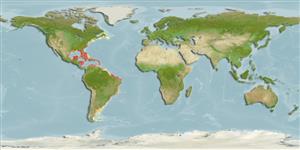>
Anguilliformes (Eels and morays) >
Ophichthidae (Snake eels) > Myrophinae
Etymology: Ahlia: Name after Jonas Nicolas Ahl, of Upsala. His thesis "De
Muræna et Ophichtho" " modestly offered for the consideration of the
president of the medical faculty" in the University of Upsala
("Carolus Vet. Thunberg") in 1789, furnishes the beginning of the
systematic arrangement of the eels.
Eponymy: Dr Jonas Nicholaus Ahl (1765–1817) was a physician and one of Linnaeus’ students. He published his thesis: De Muraena et Ophichth (1789) which according to Jordan’s dedication “furnishes the beginning of our systematic arrangement of the eels.” (Ref. 128868), visit book page.
More on author: Jordan.
Environment: milieu / climate zone / depth range / distribution range
Ecologia
marino associati a barriera corallina; distribuzione batimetrica 1 - 37 m (Ref. 37039). Tropical
Western Atlantic: Florida (USA), Bahamas, and northern Gulf of Mexico to Brazil. Northwest Atlantic: Canada.
Length at first maturity / Size / Peso / Age
Maturity: Lm 33.2, range 28 - 38.7 cm
Max length : 43.0 cm TL (female)
Pale tan with scattered tiny spots. Mature individuals darker, with red-brown band at back of head. Dorsal fin origin above or behind anus (Ref. 26938).
Inhabits seagrass beds from bays and mangroves to offshore reefs. Adults move to open sea to spawn.
Life cycle and mating behavior
Maturità | Riproduzione | Deposizione | Uova | Fecundity | Larve
Distinct pairing (Ref. 205).
Robins, C.R. and G.C. Ray, 1986. A field guide to Atlantic coast fishes of North America. Houghton Mifflin Company, Boston, U.S.A. 354 p. (Ref. 7251)
IUCN Red List Status (Ref. 130435: Version 2024-1)
Threat to humans
Harmless
Human uses
Strumenti
Special reports
Download XML
Fonti Internet
Estimates based on models
Preferred temperature (Ref.
123201): 22.7 - 28, mean 26.4 °C (based on 356 cells).
Phylogenetic diversity index (Ref.
82804): PD
50 = 1.0000 [Uniqueness, from 0.5 = low to 2.0 = high].
Bayesian length-weight: a=0.00076 (0.00029 - 0.00197), b=3.06 (2.83 - 3.29), in cm total length, based on LWR estimates for this (Sub)family-body shape (Ref.
93245).
Trophic level (Ref.
69278): 4.1 ±0.7 se; based on size and trophs of closest relatives
Resilienza (Ref.
120179): Alto, tempo minimo di raddoppiamento della popolazione meno di 15 mesi (Preliminary K or Fecundity.).
Fishing Vulnerability (Ref.
59153): Low to moderate vulnerability (33 of 100).
Nutrients (Ref.
124155): Calcium = 56 [32, 104] mg/100g; Iron = 0.597 [0.363, 1.163] mg/100g; Protein = 18.7 [16.5, 21.3] %; Omega3 = 0.117 [0.054, 0.338] g/100g; Selenium = 38.2 [21.5, 76.5] μg/100g; VitaminA = 62 [18, 189] μg/100g; Zinc = 1.11 [0.79, 1.54] mg/100g (wet weight);
